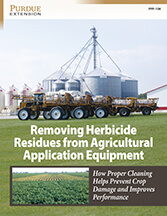Extension manual shows herbicide applicators how to clean equipment
September 24, 2015
 |
|
A new Purdue Extension publication details proper cleaning of agricultural application equipment to help prevent damage to crops and also improve equipment performance. (Purdue Agricultural Communication image) |
WEST LAFAYETTE, Ind. - Experts from Purdue Extension have compiled a manual detailing steps to ensure that herbicide residue does not linger on emptied application equipment and damage crops.
When applicator equipment isn't cleaned correctly before herbicides are switched, crops could suffer irreparable damage. That is why Fred Whitford, an Extension pesticide specialist, and some of his colleagues decided that a publication on the topic could help farmers and commercial applicators prevent such damage.
"I spent two years working on cleaning out sprayers just to see how others were doing it," Whitford said. "After two years, I was able to pinpoint a few areas that had high risk of unwanted herbicides damaging crops."
Removing Herbicide Residues from Agricultural Application Equipment is available at Purdue Extension's Education Store. Pages include pictures of every step of cleaning, examples of damaged crops and machinery parts carrying residue. The publication is intended for growers, herbicide applicators and applicator managers.
Practices such as flushing booms and screens on machines are stressed in the manual as well as the importance of not rushing cleaning procedures for the sake of time.
"Saving a few minutes by taking shortcuts during the cleanout process can almost guarantee that you will spend more time in the long run resolving contamination issues," the authors write.
Whitford said examples of damage from herbicide residue include applicators flushing screens without taking them out, not removing endcaps and failing to use a commercial tank cleaner.
"Having done a number of field days where sprayers were cleaned, growers and industry representatives were surprised to see how much residue was left in the endcaps," he said. "The truth is that this has been a problem for as long as we have been using herbicides."
Printed copies of the publication cost $5.50 each at Purdue Extension's Education Store, but it is available free for download at www.edustore.purdue.edu. Search for product code PPP-108.
Writer: Emma Hopkins, 765-494-8402, hopkine@purdue.edu
Source: Fred Whitford, 765-494-1284, fwhitford@purdue.edu
Ag Communications: (765) 494-2722;
Keith Robinson, robins89@purdue.edu
Agriculture News Page

